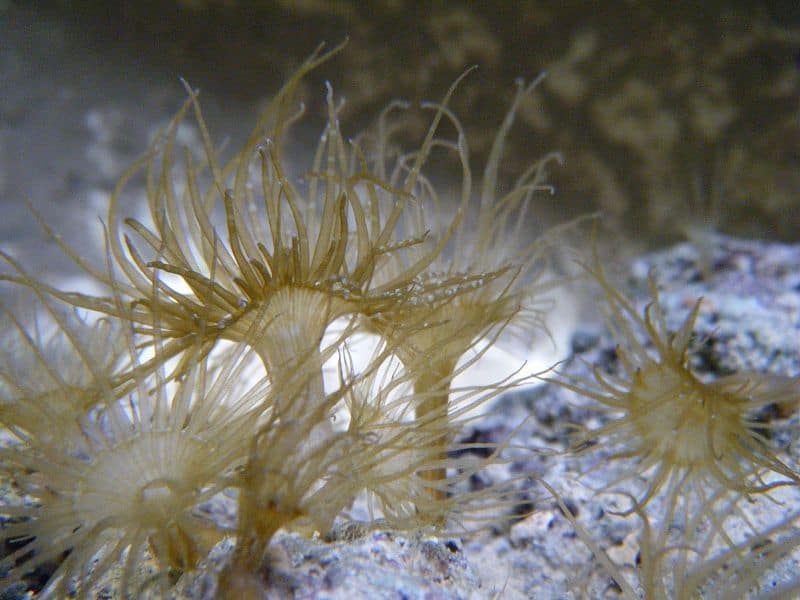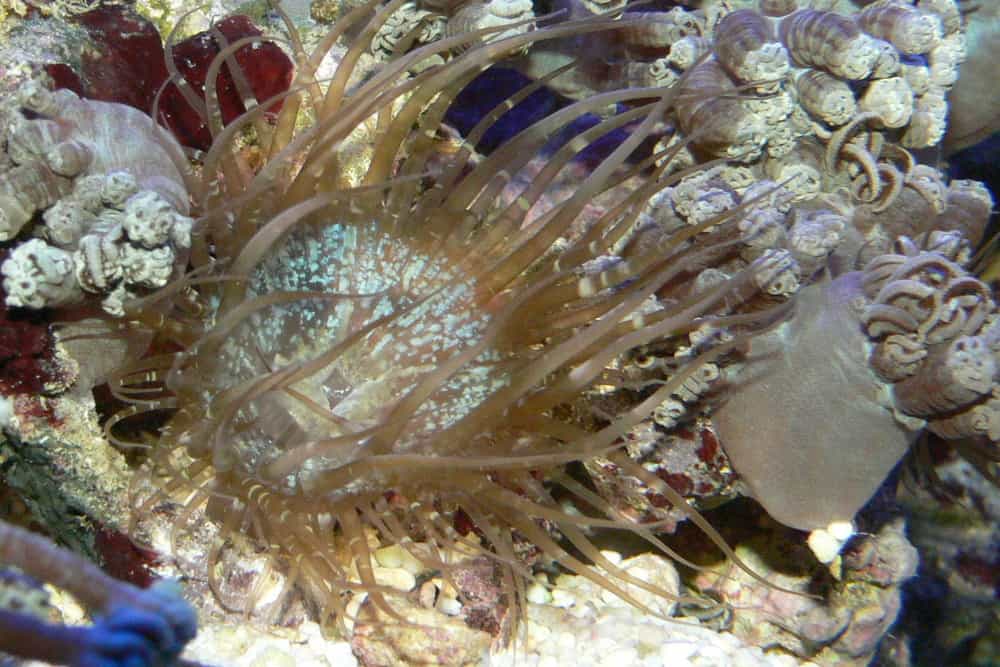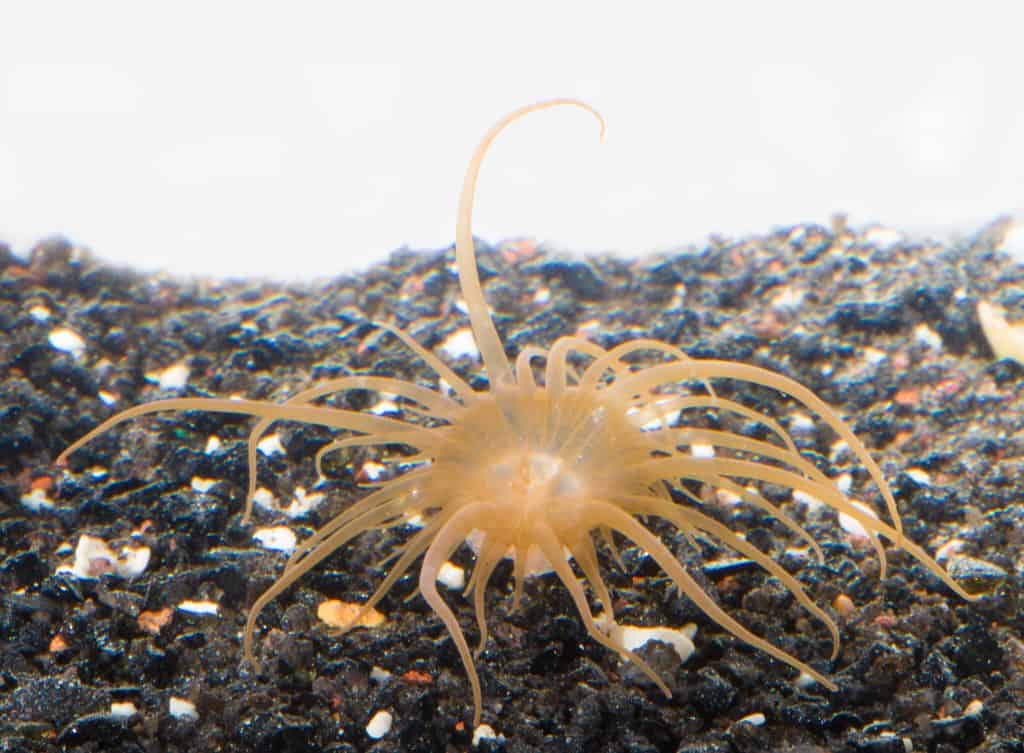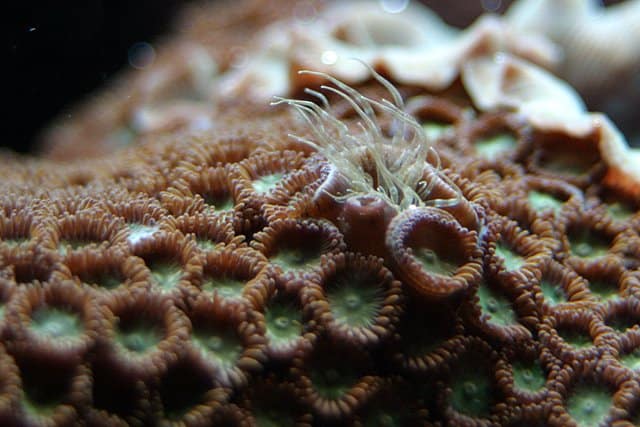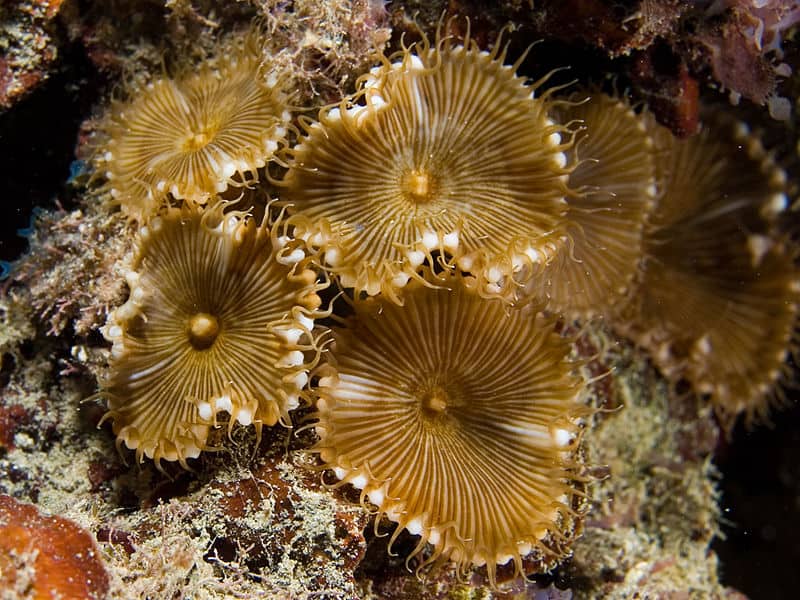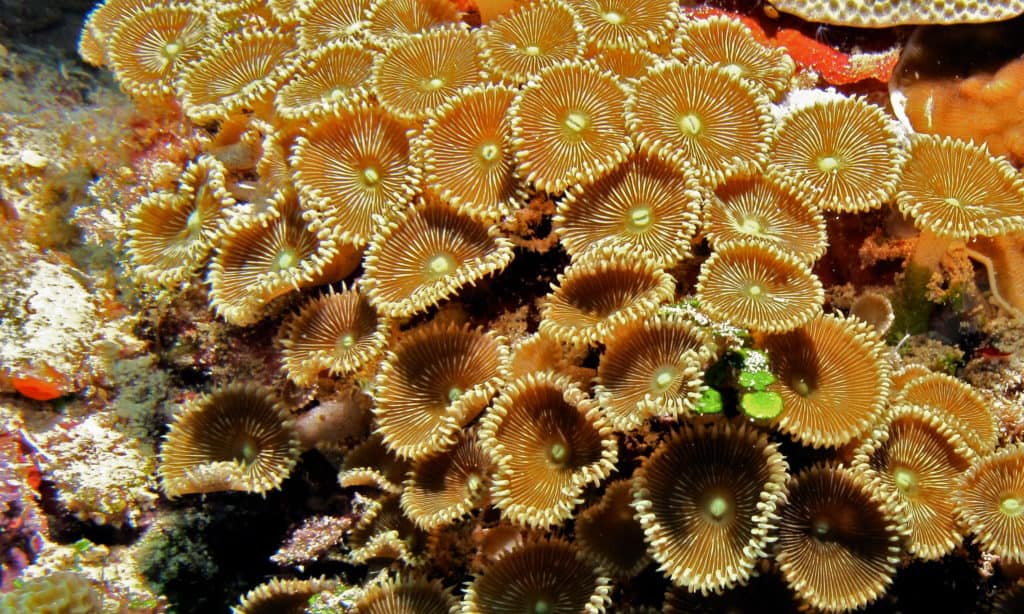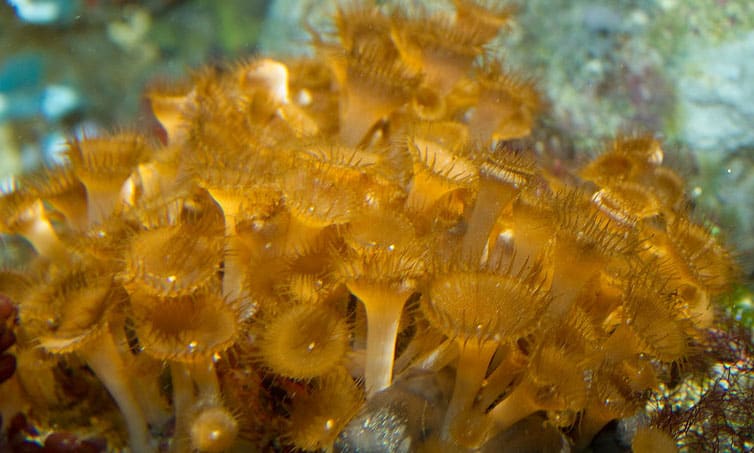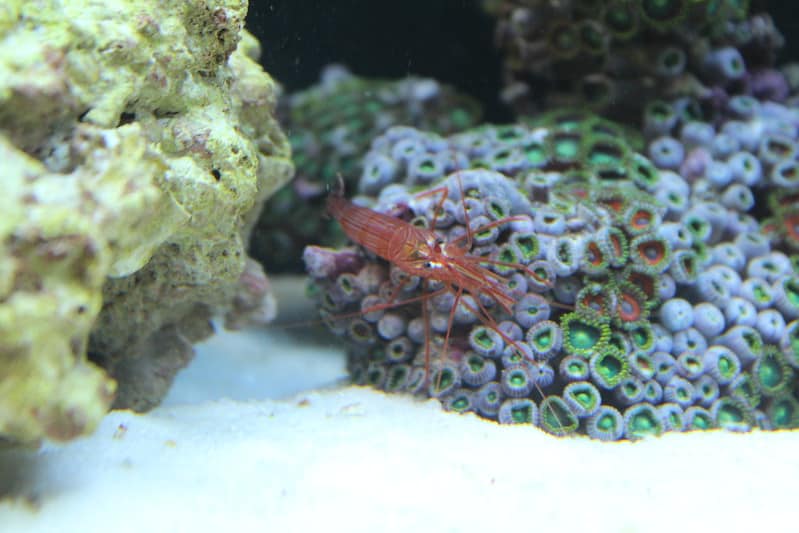Having looked after many aquariums for clients over the years the unknowing aquarist can have an aquarium soon overrun by Aiptasia because they thought it was a coral. By the time most realize what it is, trying to get rid of this common pest can be a mammoth task.
Aiptasia is an invasive species of coral that is one of the most common pests in a saltwater aquarium. It can spread rapidly, compete against other corals for food, sting its neighbors, and can be very tough to eradicate. Removal when it first appears is the best chance to prevent infestations.
Aiptasia can be eradicated using natural, predatory and chemical methods but finding it and starting the eradication process early is the key to helping keep this pest from overrunning your aquarium. Read on to find out more…
What Is Aiptasia?
This unwanted type of coral can go by several names in the hobby: Glass Anemone, Tube Anemone, Glass, and Rose Anemone. It is a member of the Anthozoa (Wiki Link) class of coral with over a dozen different species types within the Aiptasia genus.
Some of the species of Aiptasia are:
- Aiptasia californica
- Aiptasia couchii
- Aiptasia diaphana
- Aiptasia insignis
- Aiptasia inula
- Aiptasia leiodactyla
- Aiptasia mimosa
- Aiptasia minuta
- Aiptasia mutabilis
- Aiptasia prima
- Aiptasia pulchella
- Aiptasia tagetes
Each of the species above has slightly different characteristics but all present a problem to the aquarium owner. Some can be brown, some white, some have long tentacles, some short, however, the majority of the species we encounter are of the browner coloration due to the algae contained within the coral, from which it photosynthesizes to create its energy.
They grow and are very flexible. The base of the stalk could be secured deep down in a rock hole with the stalk being several inches in length to allow it to poke the crown out to receive light and passing food, and also sting anything it touches.
Another problem with Aiptasia is the hair-like projections called Acontia that cover its stalk. Just like a Venus Fly Trap, the second these detect danger, or you trying to destroy it it will quickly retract into the hole making it damn near impossible to kill it!
What Does Aiptasia Do?
Aiptasia has stinging cells in the tips of it’s tentacles that is uses to sting and kill neighboring corals and if fish if they are small enough. It rapidly reproduces causing an infestation and if pulled apart during removal, any leftover parts of the anemone grow into a new stalk.
1. Aiptasia’s Stinging Capabilities
Aiptasia has stinging cells called nematocysts at the end of each tentacle that they can use for defensive protection or offensive real-estate clearing. The toxin released by these stinging cells is potent to fish, coral, crustaceans or invertebrates that come into contact with them.
When an Aiptasia begins to grow it will use these stinging cells to attack its neighbors so it can move to occupy their location. When they move they leave behind traces of their stalk which the grow into a new head.
2. Aiptasia’s Rapid Reproduction
Aiptasia is an organism that can reproduce both sexually and asexually. This characteristic makes them even more of a challenge to eradicate. The asexual way of reproducing is by a process called Pedal Laceration.
When the Aiptasia stalk moves to a new location it leaves behind tissue which will then grow into another stalk of Aiptasia. This is why it is so important to never squash, scrub or rip off an Aiptasia stalk. All you will do is create more of the little buggers!
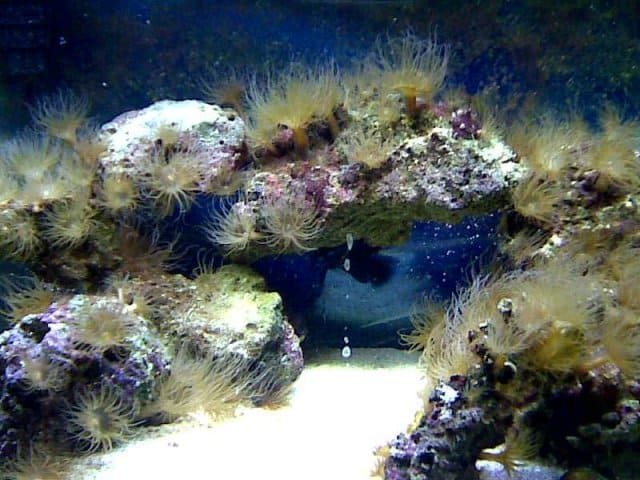
Allowed to reproduce, Aiptasia can quickly overrun an aquarium and kill all your beautiful corals! It is best to erradicate it using a natural predator or a chemical.
How Do You Identify Aiptasia?
Aiptaisa looks like a small yellow, brown or colourless coral. It has a stalk with a head like a sunflower with tentacles coming out. They can first appear small but grow to over 2″ tall. Once mature they can reproduce rapidly as they move and leave tissue behind to grow into another stalk.
Once you have seen a few Aiptasia you will soon recognize these monsters! There is one local fish store I frequent just to keep an eye on, but their aquariums are always full of Aiptasia. Needless to say, I NEVER buy livestock from them, only supplies, food, and equipment.
Many people mistake them as a coral and purchase other corals with them on the rock too. This is by far the most common way they enter an aquarium.
Here you can see the many different kinds of Aiptasia so you can know what to look for when buying live rock or coral from anyone.
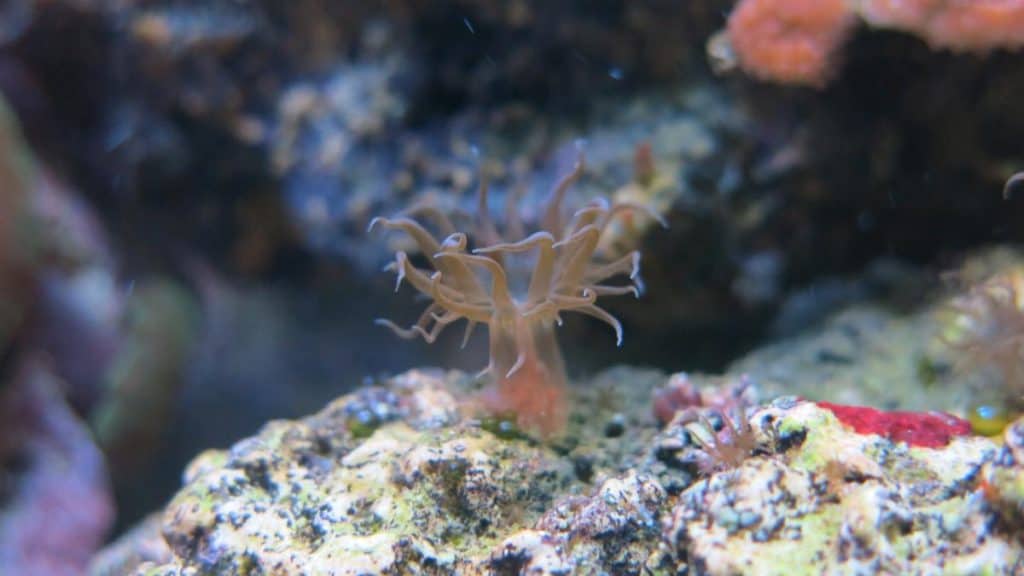
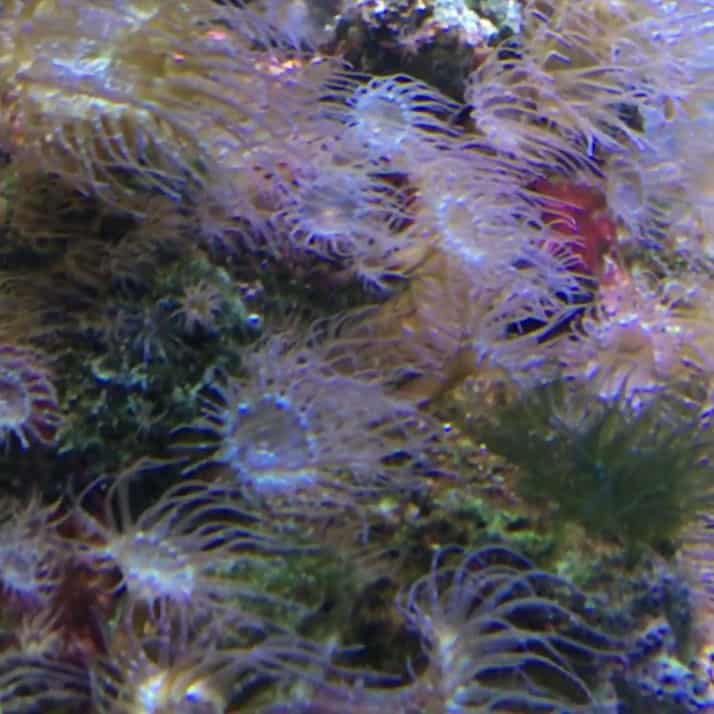
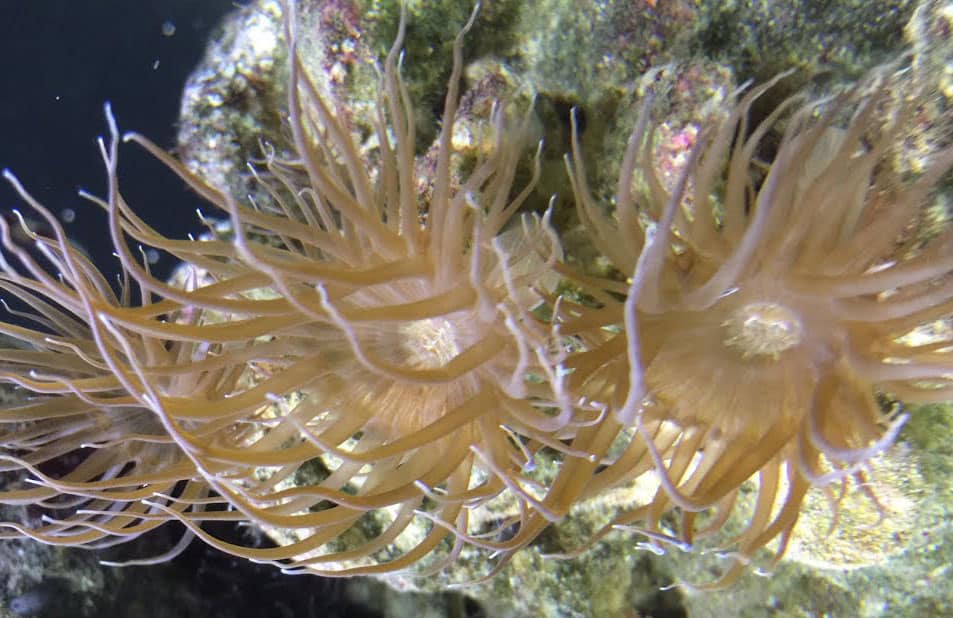
As you can see from the photos above, most of the Aiptasia you are likely to come across in this hobby are of a brown, semi-translucent coloration with long stalks and tentacles (Once they grow). They can start off just as a tiny spec of tissue and grow within weeks to a 2-inch long behemoth.
You may confuse them with a boring looking Palythoa, but introduce a frag of Aiptasia and you will soon be planting your palm on your forehead. Below are some photos of Palythoas, look at the difference in shape, tentacle length vs crown diameter.
Can Aiptasia Kill Fish?
Generally, Aiptasia kills only corals but if a small fish swims into a patch of Aiptasia the stinging cells on the tips of each stalk will release a toxin into the fish. If the sting or stings are aggressive enough it can kill the fish. The larger the Aiptasia, the more potent its sting.
By the time most people recognize a stalk of Aiptasia in their aquairum they are generally quite small and harmless. If treated quickly the stalk can be erradicated before it has time to spread or grow large enough to kill your fish.
How Do You Eradicate Aiptasia?
Aiptasia can be erradicated by using natural predators like Peppermint Shrimp or Copperband Butterfly Fish. By chemical products like Joes Juice, lemon juice, Kalkwasser paste, boiling water, or via a tool like a Majano Wand that injects a small electrical current into the stalk and kills it.
There are several proven ways to eradicate Aiptasia but most of them rely on you or an animal being able to physically get to the stalk. If you have Aiptasia buried deep inside live rock you may be in for a long battle!
The most common Aiptasia eradication methods are split into three categories:
- Livestock Methods
- Chemical Methods
- Tools
Are There Any Livestock That Kill Aiptasia?
In the wild there are three main natural predators for Aiptasia. Peppermint Shrimp, File Fish, & Copperband Butterfly fish. The Shrimp and Filefish are a great option as they are small and can be introduced into a small aquarium. The Copperband Butterflyfish fish need at least a 100 gallon aquarium.
Livestock can be one of the best forms of eradication and future prevention of Aiptasia because they are a natural food source. Below are some of the best Aiptasia predators available in our hobby:
Is There Any Shrimp That Eat Aiptasia?
Peppermint Shrimp (Lysmata wurdemanni)
This Reef-Safe, Aiptasia-eating shrimp is one of the easiest and most affordable lines of defense in your arsenal. Most aquarists will place a Peppermint Shrimp into their aquarium during its early post-cycle days to allow this guy to begin hunting for Aiptasia.
Catching Aiptasia early before it has a chance to reproduce is the key and this shrimp will be scouring every inch of your tank and devouring any Aiptasia it finds. Being able to reach into tight cracks and holes allows this guy to get to the most stubborn Aiptasia stalks.
The Peppermint Shrimp is great for any size aquarium, especially small Nano-Tanks that cannot accommodate the larger Aiptasia predators.
Be aware of imposters being sold as Peppermint Shrimp. Only the Lysmata wurdemanni species are natural predators of Aiptasia. Look-a-Likes and other shrimp will not touch them.
Is There Any Fish That Eat Aiptasia?
FileFish (Acreichthys tomentosus)
This funny-looking camouflaged fish has a natural diet of Aiptasia as well as other foods making them ideal to help thin out a raging Aiptasia outbreak.
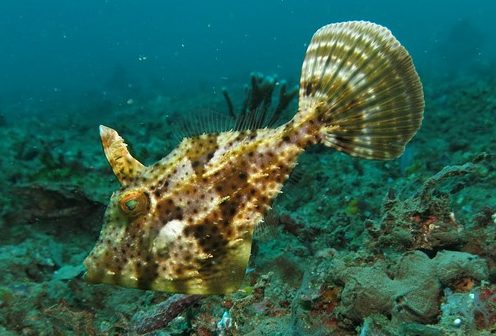
Just as with the shrimp, be mindful to get the correct fish as other similar fish will not prey on the Aiptasia. Be sure to reference the Latin name to ensure you are purchasing the correct species.
These fish can grow up to around 2-3″ in length so an aquarium of at least 30 gallons is an absolute minimum.
Copperband Butterflyfish (Chelmon rostratus)
One of my all-time favorite fish however, they are also one of the most difficult Aiptasia eating fish to keep. The CBB can be hit or miss on whether or not they will eat your Aiptasia. I have seen some demolish an entire tank full in a matter of days and yet, I have seen others that will not touch the stuff.
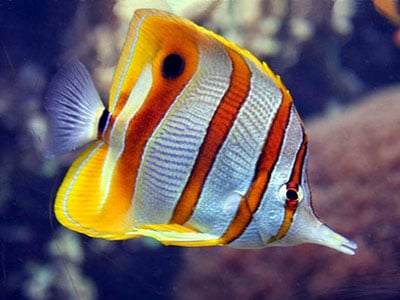
The other problem with the CBB is that they are VERY picky eaters and most do not eat after the Aiptasia is gone, leading them to a slow, starving death. I have owned 3 CBB’s in my aquatic career and even with doted feeding methods, I have not been able to keep them.
Being a Butterfly, they require a large aquarium of at least 75 gallons and even then that is on the small side if you already have any larger fish in there. If you find you must have a CBB to eradicate your Aiptasia see if you can arrange a deal to bring it back to the store or move it on to an experienced aquarist who can keep them.
Are There Any Chemicals That Kill Aiptasia?
Boiling RO/DI Water
This can be a great way to kill Aiptaisia but it can be time-consuming and difficult. By injecting boiling RO/DI water from a syringe into the mouth of an Aiptasia stalk you can instantly kill it. However, getting it into the mouth is very difficult as they close up rapidly.
The other problem with this is you could harm neighboring corals if you get boiling water on them and you cannot always get to the Aiptasia to inject them.
Also, make sure you DO NOT use Tap Water as this could give you algae problems!
Lemon Juice
Just like boiling water, lemon juice can also be injected into the head of Aiptasia, but again it is time-consuming and you have to have access to the mouth on each Aiptasia head for this to work.
Kalkwasser
Kalkwasser is a powdered lime product that is used to help maintain Ph and alkalinity in your aquarium. By mixing up a thick solution, inserting it into a syringe and covering the Aiptasia head with this stuff it just melts it away.
I have only ever had one or two Aiptaisia come into my aquarium and this has worked very well for me, but I was also able to get access to the Aiptasia head too! If you have lots of Aiptasia this is also not one of the better ways to eradicate it.
Off-The-Shelf Products
There are a few commercially produced products that can work great in eradicating your Aiptasia problem, however, all of these chemical products require application via a syringe. No access = No Eradication.
Some of the most popular products are:
Links to Amazon.com
Are There Any Tools That Kill Aiptasia?
Aiptasia/Majano Wand
The wand is a great little device that when touched to an Aiptasia causes the water inside it to turn to Hydrogen and imploding the Aiptasia stalk. Access is needed to each head but it’s a fun way to Zap those pests!
You can find the Majano Wand Here at Amazon.com
Can You Pull or Scrape Off Aiptasia?
Pulling or scraping should not be undertaken when trying to eradicate an Aiptasia. Pulling or scraping off stalks of Aiptasia will allow it to reproduce aggressively within the aquarium. Each piece of flesh that is left on the rock or floats away in the water will grow into another stalk of Aiptasia.
By far the best methods are mentioned above and pulling or scraping an Aiptasia stalk will turn a small problem into a huge mess.
Where Does Aiptasia Come From?
Most Aiptasia enters your aquarium on either frag coral or piece of live rock. They can be so small you do not see them, or be hidden within the rock. To ensure no Aiptasia enters your aquarium use Live Rock from a reputable dealer & dip, scrutinize, & quarantine every coral frag you purchase.
If you build your initial aquascape using live rock then there are a few things you can do to help minimize the introduction of Aiptasia and other pests:
Closely inspect the tank from which the live rock is coming from. If it contains Aiptasia or other pests, walk away.
Buy live rock from reputable dealers that have pest-free live rock storage facilities.
Before inserting rock into your aquarium carefully inspect every single piece of rock with a flashlight and magnifying glass as thoroughly as you can.
During the aquarium cycle be on the lookout for ANY pests and eradicate them as soon as you see them. If you see any pests you cannot get to, remove the rock and give it a bleach bath to kill everything. Thoroughly soak, scrub and rinse with clean water. The rock will have no life left on it, but will soon re-seed when it gets placed back in the aquarium with the other rock. Be aware of Palytoxin when doing this!
You can find out more on Palytoxin Poisoning in my article HERE
Every time you purchase a coral you need to fully inspect the coral and the ceramic plug it comes on for pests and algae. This is by far the most common way most pests enter an aquarium.
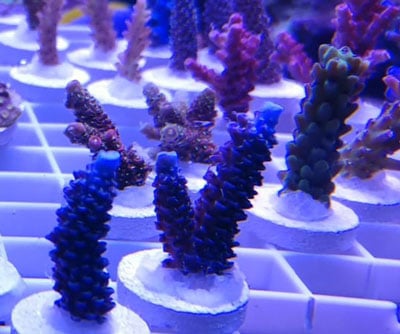
This is how I got Bubble Algae into my system, even though I thoroughly inspect and dip every frag. The problem is the pest can be in a microscopic stage and you don’t see it. If I can, I will always mount the coral onto a new, clean frag plug, but if the coral has already started to grow over the plug I leave it be and give it a very good inspection.
After inspection, I give the plugs a scrub with a toothbrush and a scrape with an Exacto blade, then dip the coral in a coral cleaning solution.
To learn more about live rock, dry rock, and coral dipping please see the ‘Further Reading’ section at the end of this article.
To Finish
Finding Aiptasia in your aquarium is not the end of the world and I am pretty sure no aquarist has gone through their life without ever having to deal with at least a head or two of this pest.
If you only have a small number that you can access then one of the syringe methods will be your best bet, but if you have let them go unchecked and you now have a mini-forest, I suggest a natural predator will be your best bet!
Further Reading
If you found this helpful and would like information on other aspects of this hobby then please head over to one of my other articles:

